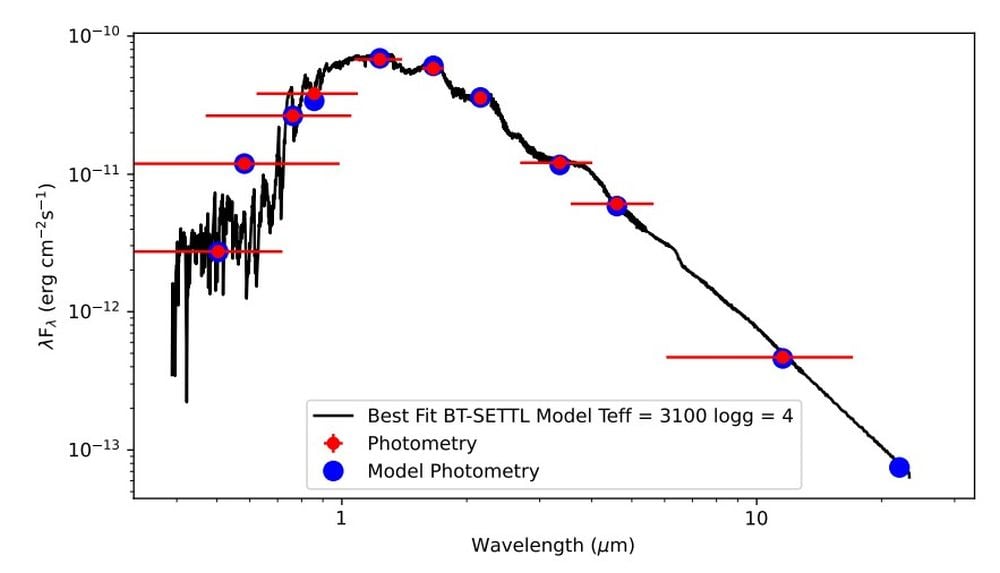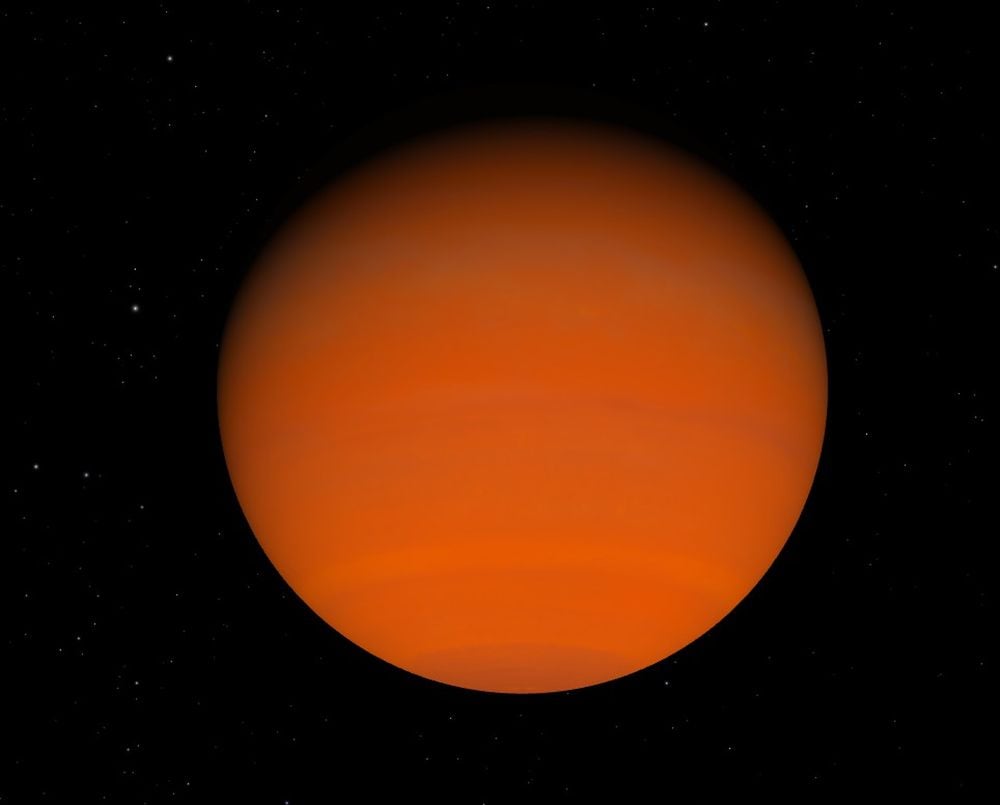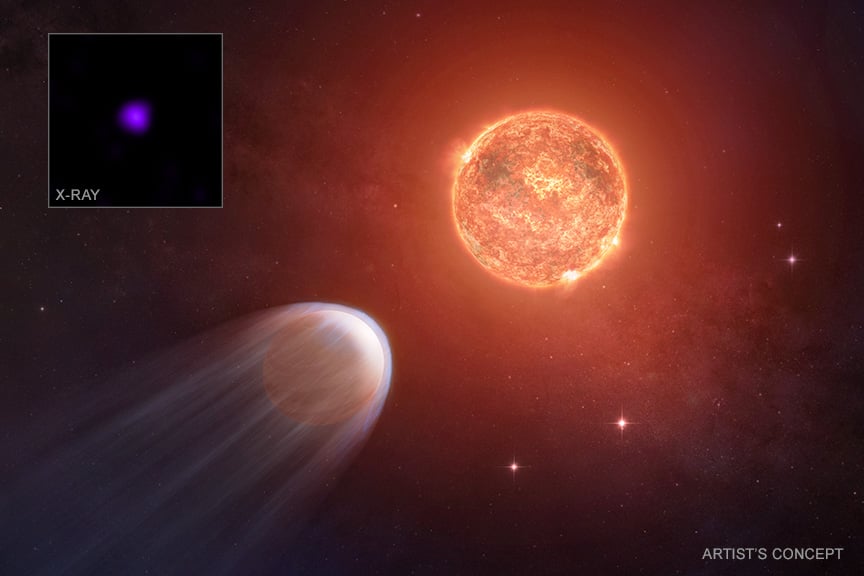Stars and planets are naturally associated with one another. While some planets have gone rogue and are drifting through space, the vast majority are in solar systems, where they’re gravitationally bound and orbit their stars in predictable ways. But some planets stray too close to their stars, with dire consequences. These exoplanets have something to teach us about the exoplanet population.
Our exoplanet discoveries (~6,000 and counting) have shown us that our Solar System is not representative. Other solar systems contain planets nothing like ours, in orbits not seen in our Solar System. TOI-1227b is one of them.
TOI-1227b is a roughly Jupiter-size planet with about 20% of Jupiter’s mass. It orbits an M-dwarf, or red dwarf star, about 330 light-years away. It was discovered in 2022 in data from NASA’s Transiting Exoplanet Survey Satellite (TESS).
TOI-1227b is suffering an existential crisis. It orbits extremely close to its star, only about 1/5th as far away as Mercury is from the Sun. New research shows that this planet is young, only about eight million years old. It’s a diaper-wearing infant when compared to Earth. Sadly for this young planet, instead of putting on weight, it’s losing its mass.
The research is titled “The Age and High Energy Environment of the Very Young Transiting Exoplanet TOI 1227b,” and will be published in The Astrophysical Journal but is available at arxiv.org. The lead author is Attila Varga, a Ph.D. student at the Rochester Institute of Technology (RIT) in New York. At only eight million years old, the exoplanet is the second youngest planet astronomers have ever found transiting in front of its star.
“We have conducted new X-ray imaging and optical spectroscopic observations of TOI 1227 aimed at ascertaining its age and the influence of its high-energy radiation on the exoplanet, TOI 1227b,” the researchers write.
The star it orbits, TOI-1227, is much smaller and dimmer than the Sun. As an M-dwarf, it’s far less massive than the Sun, and much dimmer in visible light. However, that dimness doesn’t describe the entire spectrum of the star’s output.
M-dwarfs are notorious for their extreme flaring, which produces powerful X-rays. Unlike the Sun, M-dwarfs are fully convective. Convection takes place throughout the interior of the star, which creates the powerful magnetic fields responsible for the flaring. In TOI-1227 b’s case, the unfortunate young gas giant is right in the crosshairs of this destructive flaring.
This illustration shows how low-mass, M-dwarf stars are fully convective. This convection creates the stars’ powerful, destructive flaring. Image Credit: NASA/CXC/M.Weiss
“It’s almost unfathomable to imagine what is happening to this planet,” said lead author Varga in a press release. “The planet’s atmosphere simply cannot withstand the high X-ray dose it’s receiving from its star.”
“Our modeling suggests that TOI 1227b is currently undergoing rapid atmospheric mass loss at rates on the order of ∼ 10^12 g s^−1,” the authors write. That equates to losing about 1 million metric tons of its atmosphere every single second. Varga and his co-authors calculated that in only one billion years, the planet will lose its entire atmosphere.
Powerful X-rays from stars like TOI 1227 strip away exoplanet atmospheres with several different, yet connected, mechanisms.
 This figure shows TOI-1227’s spectral energy distribution. The red points are from archival photometry from GAIA, 2MASS, and WISE, and blue points are synthetic photometry points from an atmospheric model. The black line represents the best fit. Since X-rays span from about 0.01 to 10 nanometers, the figure shows that X-rays are blasting away at the exoplanet TOI-1227b. Image Credit: Varga et al. 2025. The Astrophysical Journal.
This figure shows TOI-1227’s spectral energy distribution. The red points are from archival photometry from GAIA, 2MASS, and WISE, and blue points are synthetic photometry points from an atmospheric model. The black line represents the best fit. Since X-rays span from about 0.01 to 10 nanometers, the figure shows that X-rays are blasting away at the exoplanet TOI-1227b. Image Credit: Varga et al. 2025. The Astrophysical Journal.
When X-rays strike molecules in the atmosphere, they ionize them and heat them up. This can heat the atmosphere to thousands of degrees Kelvin, which makes the atmosphere puff up. As the atmosphere extends further into space, the planet’s gravity has a weaker hold on it. The heating can be even more extreme in some cases, and this can essentially boil away some lighter molecules like molecular hydrogen.
Photodissociation plays a role, too. X-rays have enough energy to break water molecules apart into hydrogen and oxygen atoms. Since hydrogen is so light, it can easily escape to space. On top of that, the X-rays can raise the temperature of the star’s stellar wind, giving it more energy and making it more efficient at stripping away the atmosphere.
“A crucial part of understanding planets outside our solar system is to account for high-energy radiation like X-rays that they’re receiving,” said co-author Joel Kastner, also of RIT. “We think this planet is puffed up, or inflated, in large part as a result of the ongoing assault of X-rays from the star.”
The researchers think that the planet is losing the mass equivalent to two Earth atmospheres every two centuries. While many things astronomers discover take a long time to play out, this is happening much more quickly. Most things in astronomy are measured in millions or billions of years, not centuries.
“The future for this baby planet doesn’t look great,” said co-author Alexander Binks of the Eberhard Karls University of Tübingen in Germany. “From here, TOI 1227 b may shrink to about a tenth of its current size and will lose more than 10 percent of its weight.”
 A hypothetical visualization of TOI-1227b. The planet is rapidly losing its atmosphere as intense X-ray radiation from its star strips it away. Image Credit: NASA Eyes on Exoplanets
A hypothetical visualization of TOI-1227b. The planet is rapidly losing its atmosphere as intense X-ray radiation from its star strips it away. Image Credit: NASA Eyes on Exoplanets
Some of these numbers are not exact, because a lot depends on understanding the mass of the planet. In this case, that mass is proving elusive to determine exactly. To come up with these numbers, the team performed multiple simulations and settled on the most likely outcomes.
There’s a small planet radius gap in the exoplanet population, where planets with radii between 1.5 and 2 times Earth’s radius are very scarce. Photo-evaporation driven mass loss is the suspected cause of this gap, and astronomers want to observe planets like TOI 1227b to learn more about the process.
“The nearby, young transiting exoplanet system TOI 1227 represents a vital benchmark for understanding very early stages of exoplanet evolution around low-mass stars,” the researchers conclude, noting that “Follow-up photometric and spectroscopic observations aimed at further establishing the nature of the TOI 1227 system and providing tighter constraints on the mass and atmospheric mass loss,” are needed.
